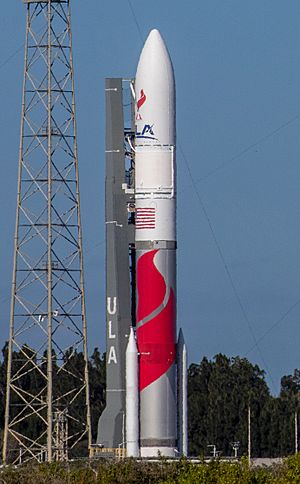Vulcan Centaur facts for kids
 |
|

Vulcan Centaur ahead of its first flight
|
|
| Function | Launch vehicle, partial reuse planned |
|---|---|
| Manufacturer | United Launch Alliance |
| Country of origin | United States |
| Cost per launch | Approx. US$100–200 million |
| Size | |
| Height | 61.6 m (202 ft) |
| Diameter | 5.4 m (18 ft) |
| Mass | 546,700 kg (1,205,300 lb) |
| Stages | 2 with 0, 2, 4 or 6 boosters |
| Capacity | |
| Payload to low Earth orbit (28.7°) | 27,200 kg (60,000 lb) |
| Payload to geostationary transfer orbit (27.0°) | 15,300 kg (33,700 lb), |
| Payload to geostationary orbit | 7,000 kg (15,000 lb) |
| Payload to trans-lunar injection | 12,100 kg (26,700 lb) |
| Launch history | |
| Status | Operational |
| Launch sites |
|
| Total launches | 1 |
| Successes | 1 |
| First flight | 8 January 2024 2:18 AM ET (7:18 UTC) |
| Boosters | |
| No. boosters | 0, 2, 4, or 6 |
| Motor | GEM-63XL |
| Thrust | 2,201.7 kN (495,000 lbf) |
| Fuel | HTPB, Al / AP |
| First stage | |
| Diameter | 5.4 m (18 ft) |
| Engines | 2 × BE-4 |
| Thrust | 1,100,000 lbf (4,900 kN) |
| Fuel | CH4 / LOX |
| Second stage – Centaur V | |
| Diameter | 5.4 m (18 ft) |
| Engines | 2 × RL-10 |
| Thrust | 212 kN (48,000 lbf) |
| Specific impulse | 453.8 s (4.450 km/s) |
| Fuel | LH2 / LOX |
Vulcan Centaur is a two-stage-to-orbit, heavy-lift launch vehicle developed by United Launch Alliance (ULA).
It will replace the existing heavy-lift launch systems (Atlas V and Delta IV Heavy) due to their retirement. Vulcan Centaur will also be used for commercial launches.
Development of the Vulcan rocket started in 2014, largely in response to growing competition from SpaceX and a desire to phase out the Russian RD-180 used on the Atlas V.
Vulcan Centaur launched for the first time on 8 January 2024, successfully carrying Astrobotic Technology's Peregrine lunar lander, the first mission on NASA's Commercial Lunar Payload Services (CLPS) program.
History
ULA had considered a number of launch vehicle concepts in the decade since the company was formed in 2006.
In early 2014, geopolitical and US political considerations led to an effort by ULA to consider the possible replacement of the Russian-supplied RD-180 engine used on the first stage booster of the Atlas V.
In September 2014, ULA announced that it had entered into a partnership with Blue Origin to develop the BE-4 liquid oxygen (LOX) and liquid methane (CH4) engine to replace the RD-180 on a new first stage booster.
Vulcan deployment was expected to begin with a new first stage that was based on the Delta IV's fuselage diameter and production process, and initially expected to use two BE-4 engines or the AR1 as an alternative. The second stage was to be the existing Centaur III, already used on Atlas V. A later upgrade, the Advanced Cryogenic Evolved Stage (ACES), was conceptually planned to be introduced a few years after Vulcan's first flight. ULA also announced a design concept for reuse of the Vulcan booster engines, thrust structure and first stage avionics, which could be detached as a module from the propellant tanks after booster engine cutoff; the module would re-enter the atmosphere behind an inflatable heat shield.
Capabilities
A single-core Vulcan Centaur with six solid rocket boosters can put 27,200 kilograms into low-Earth orbit, nearly as much as the three-core Delta IV Heavy.
The payload capacity of Vulcan Centaur are as follows:
| Version | SRBs | Payload mass to... | ||||||
|---|---|---|---|---|---|---|---|---|
| LEO | ISS | Polar | MEO | GEO | GTO | TLI | ||
| Vulcan Centaur VC0 | 0 | 10,800 kg (23,800 lb) | 9,200 kg (20,300 lb) | 8,500 kg (18,700 lb) | N/A | N/A | 3,500 kg (7,700 lb) | 2,300 kg (5,100 lb) |
| Vulcan Centaur VC2 | 2 | 19,000 kg (42,000 lb) | 16,300 kg (35,900 lb) | 15,200 kg (33,500 lb) | 3,900 kg (8,600 lb) | 2,600 kg (5,700 lb) | 8,400 kg (18,500 lb) | 6,300 kg (13,900 lb) |
| Vulcan Centaur VC4 | 4 | 24,600 kg (54,200 lb) | 21,600 kg (47,600 lb) | 20,000 kg (44,000 lb) | 6,200 kg (13,700 lb) | 4,900 kg (10,800 lb) | 11,700 kg (25,800 lb) | 9,200 kg (20,300 lb) |
| Vulcan Centaur VC6 | 6 | 27,200 kg (60,000 lb) | 25,800 kg (56,900 lb) | 23,900 kg (52,700 lb) | 8,100 kg (17,900 lb) | 6,500 kg (14,300 lb) | 14,500 kg (32,000 lb) | 11,500 kg (25,400 lb) |
| Vulcan Upgrade | 6 | 27,200 kg (60,000 lb) | 26,900 kg (59,300 lb) | 24,900 kg (54,900 lb) | 8,600 kg (19,000 lb) | 7,000 kg (15,000 lb) | 15,300 kg (33,700 lb) | 12,100 kg (26,700 lb) |
See also
 In Spanish: Vulcan (cohete) para niños
In Spanish: Vulcan (cohete) para niños
- Heavy-lift launch vehicle
- Comparison of orbital launch systems
- OmegA
- New Glenn
- Falcon 9
- Falcon Heavy

